Icelandic volcano could erupt for years, creating “perfect tourist” attraction, Reuters, PBS News, NBC News, Global News, TED-Ed, NASA and NASA Scientific Visualization Studio
PBS NewsHour full episode, Apr. 2, 2021
NBC Nightly News Broadcast (Full) – April 2nd, 2021
Reuters Photographs: Icelandic volcano could erupt for years, creating “perfect tourist” attraction
Iceland volcano eruption offers “most beautiful” lava show, Mar 22, 2021, Global News
Iceland volcano: Drone footage captures stunning up-close view of eruption, Mar 24, 2021, Global News
Volcanic eruption explained – Steven Anderson, Jul 13, 2020 TED-Ed
The colossal consequences of supervolcanoes – Alex Gendler, Jun 9, 2014 TED-Ed
NASA Helps the World Weather the 2020 Hurricane Season, Program area Disasters Region North America, South America, by Timothy “Seph” Allen, Published Thursday, February 25, 2021
2020 Hurricane Season, Feb 25, 2021, NASA Scientific Visualization Studio
https://www.youtube.com/watch?v=dkQVx3gkAHk
PBS NewsHour full episode, Apr. 2, 2021
Apr 2, 2021 PBS NewsHour
Friday on the NewsHour, a strong jobs report offers signs of hope for an economic recovery, new laws across the country try to combat racial discrimination based on how you wear your hair, and David Brooks and Jonathan Capehart consider President Biden’s new infrastructure plan and Major League Baseball’s reaction to Georgia’s new voting law. WATCH TODAY’S SEGMENTS News Wrap: Officer, suspect killed in attack at U.S. Capitol https://www.youtube.com/watch?v=1v5OM…? Jobs report offers signs of hope for an economic recovery https://www.youtube.com/watch?v=vr_AV…? U.S. opens the door to a new nuclear deal with Iran https://www.youtube.com/watch?v=ABP1L…? How hair discrimination impacts Black Americans https://www.youtube.com/watch?v=TOrw7…? Brooks and Capehart on Biden’s new infrastructure plan https://www.youtube.com/watch?v=N7ZDl…? Honoring 5 phenomenal people who lost their lives to COVID https://www.youtube.com/watch?v=IyJVj…? New Mexico inmates connect with Hemingway’s life and work https://www.youtube.com/watch?v=tmbh0…? Stream your PBS favorites with the PBS app: https://to.pbs.org/2Jb8twG? Find more from PBS NewsHour at https://www.pbs.org/newshour? Subscribe to our YouTube channel: https://bit.ly/2HfsCD6? Follow us: Facebook: http://www.pbs.org/newshour? Twitter: http://www.twitter.com/newshour? Instagram: http://www.instagram.com/newshour? Subscribe: PBS NewsHour podcasts: https://www.pbs.org/newshour/podcasts? Newsletters: https://www.pbs.org/newshour/subscribe?
https://www.youtube.com/watch?v=mFHn8FC1x4U
NBC Nightly News Broadcast (Full) – April 2nd, 2021 | NBC Nightly News
Apr 2, 2021 NBC News
Police officer killed in vehicle attack at U.S. Capitol, top Minneapolis police lieutenant says Derek Chauvin’s use of force “totally unnecessary,” and U.S. economy adds 916,000 jobs in March. Watch “NBC Nightly News With Lester Holt” at 6:30 p.m. ET / 5:30 p.m. CT (or check your local listings). 00:00? Intro 02:12? Capitol Police Officer Killed In Vehicle Attack 04:12? Police: Second Capitol Officer In Stable Condition 04:24? Biden ‘Heartbroken’ Over Officer’s Death At Capitol 04:47? Capitol Attacker Identified As 25-Year-Old From Virginia 05:44? Police: No Indication Capitol Attack Terror Related 05:55? Capitol Has Been On High Alert Since January 6 Riot 06:23? Investigators Searching Capitol Attackers Social Media 06:52? Capitol Police Ask For Prayers After Deadly Attack 07:16? Capitol Police Remain On Edge Since January 6 Riot 07:43? Officer William Evans Killed In Capitol Attack 08:20? Capitol Attack Raises New D.C. Security Questions 10:00? Lieutenant: Chauvin’s Use Of Force ‘Totally Unnecessary’ 11:00? Chauvin’s Ex-Supervisor: Floyd Restrained Too Long 11:17? Chauvin Told Ex-Supervisor Floyd ‘Was Going Crazy’ 11:32? Prosecutors Allege Chauvin Used Excessive Force 12:15? CDC: Fully Vaccinated People Can Travel Safely In U.S. 13:58? CDC Issues New Guidance For Resuming Cruises 14:20? New Mexico Leads U.S. IN Race To Herd Immunity 16:32? MLB Moves All-Star Game Over Georgia Voting Law 16:54? U.S. Adds 900,000+ Jobs In March As Hiring Surges 18:55? NBC News Correspondent Bill Neely Announces Retirement » Subscribe to NBC News: http://nbcnews.to/SubscribeToNBC? » Watch more NBC video: http://bit.ly/MoreNBCNews? Connect with NBC Nightly News online! NBC News App: https://smart.link/5d0cd9df61b80? Breaking News Alerts: https://link.nbcnews.com/join/5cj/bre…? Visit NBCNightlyNews.com: https://nbcnews.to/2wFotQ8? Find Nightly News on Facebook: https://bit.ly/2TZ1PhF? Follow Nightly News on Twitter: https://bit.ly/1yFY2s4? Follow Nightly News on Instagram: https://bit.ly/2tEncJD? NBC News Digital is a collection of innovative and powerful news brands that deliver compelling, diverse and engaging news stories. NBC News Digital features NBCNews.com, MSNBC.com, TODAY.com, Nightly News, Meet the Press, Dateline, and the existing apps and digital extensions of these respective properties. We deliver the best in breaking news, live video coverage, original journalism and segments from your favorite NBC News Shows. #GeorgeFloyd? #CovidVaccine? #NBCNews? NBC Nightly News Broadcast (Full) – April 2nd, 2021 | NBC Nightly News
Reuters Photographs: Icelandic volcano could erupt for years, creating “perfect tourist” attraction
https://www.reuters.com/news/picture/icelandic-volcano-could-erupt-for-years-idUSRTXB2C23
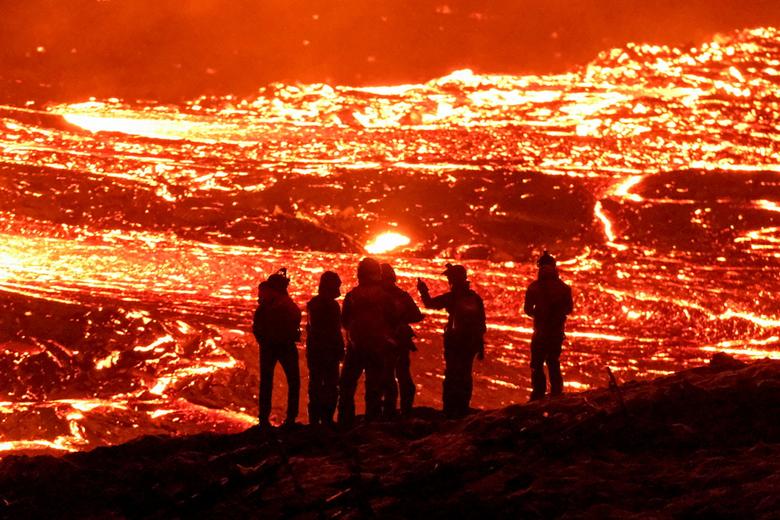 Reuters / Sunday, March 21, 2021
Reuters / Sunday, March 21, 2021
A volcanic eruption in Geldingadalur in Iceland’s Reykjanes peninsula, March 20. The volcano in Iceland spewing lava into the sky could continue its spectacular display for years, potentially becoming a new tourist attraction on the island known for its natural wonders. Kristinn Magnusson/mbl.is via REUTERS
 Volcanic eruption in Geldingadalur in Reykjanes peninsula in Iceland, March 20. Kristinn Magnusson/mbl.is via REUTERS
Volcanic eruption in Geldingadalur in Reykjanes peninsula in Iceland, March 20. Kristinn Magnusson/mbl.is via REUTERS
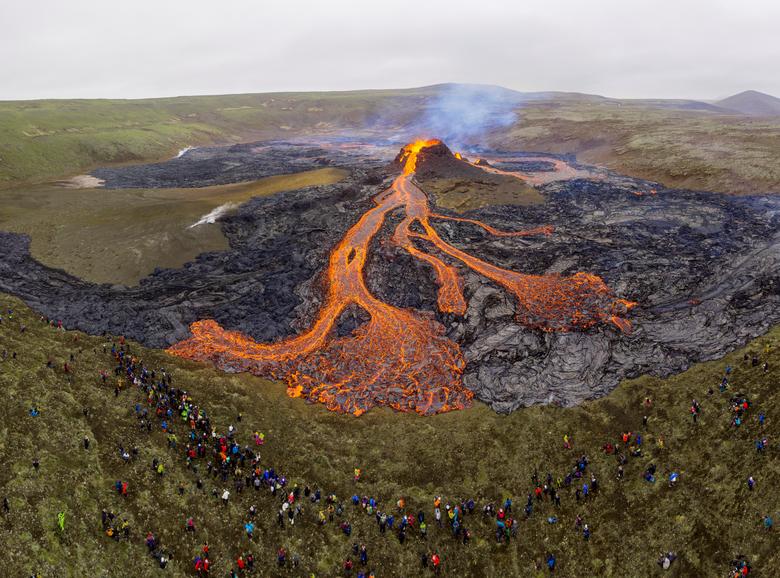 Reuters / Monday, March 22, 2021
Reuters / Monday, March 22, 2021
A view of the volcanic site on the Reykjanes Peninsula in Iceland, March 21. Thousands of Icelanders have flocked to the site of the eruption, some 30 kilometres southwest of the capital, hoping to be awed by the rare lava fountains and even to cook a meal on the scorching crust of magma. REUTERS/Cat
A view of the volcanic site on the Reykjanes Peninsula following Friday’s eruption in Iceland, March 21. REUTERS/Cat Gundry-Beck
 Lava flows from a volcano in the Reykjanes Peninsula, Iceland, March 21. REUTERS/Sigtryggur Johannsson
Lava flows from a volcano in the Reykjanes Peninsula, Iceland, March 21. REUTERS/Sigtryggur Johannsson
 People visit a volcanic site on the Reykjanes Peninsula in Iceland, March 26. REUTERS/Cat Gundry-Beck
People visit a volcanic site on the Reykjanes Peninsula in Iceland, March 26. REUTERS/Cat Gundry-Beck
 A tourist poses for pictures at a volcanic site on the Reykjanes Peninsula in Iceland, March 26. REUTERS/Cat Gundry-Beck
A tourist poses for pictures at a volcanic site on the Reykjanes Peninsula in Iceland, March 26. REUTERS/Cat Gundry-Beck
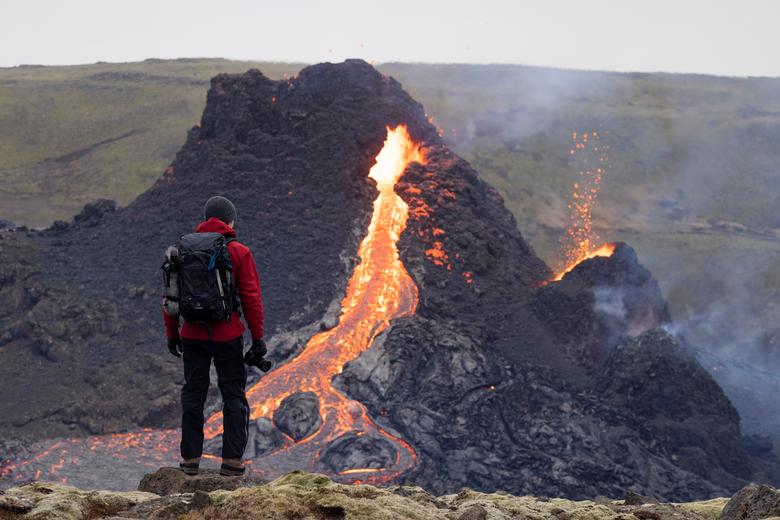 Reuters / Monday, March 22, 2021
Reuters / Monday, March 22, 2021
A person stands in front of the volcanic site on Iceland’s Reykjanes Peninsula, March 21. To cope with the hoard of visitors, authorities in Iceland set up a 3.5 kilometre (2.2 miles) hiking trail to the eruption site and are patrolling the area to prevent onlookers from venturing into hazardous areas polluted by volcanic gasses. REUTERS/Cat Gundry-Beck
 A volcanic site on the Reykjanes Peninsula in Iceland March 27. REUTERS/Cat Gundry-Beck
A volcanic site on the Reykjanes Peninsula in Iceland March 27. REUTERS/Cat Gundry-Beck
 People gather at the volcanic site on Iceland’s Reykjanes Peninsula, March 21. REUTERS/Cat Gundry-Beck
People gather at the volcanic site on Iceland’s Reykjanes Peninsula, March 21. REUTERS/Cat Gundry-Beck
 A volcanic eruption in Geldingadalur in Iceland’s Reykjanes peninsula, March 20. Thousands of curious onlookers have been flocking to the erupting volcano. Kristinn Magnusson/mbl.is via REUTERS
A volcanic eruption in Geldingadalur in Iceland’s Reykjanes peninsula, March 20. Thousands of curious onlookers have been flocking to the erupting volcano. Kristinn Magnusson/mbl.is via REUTERS
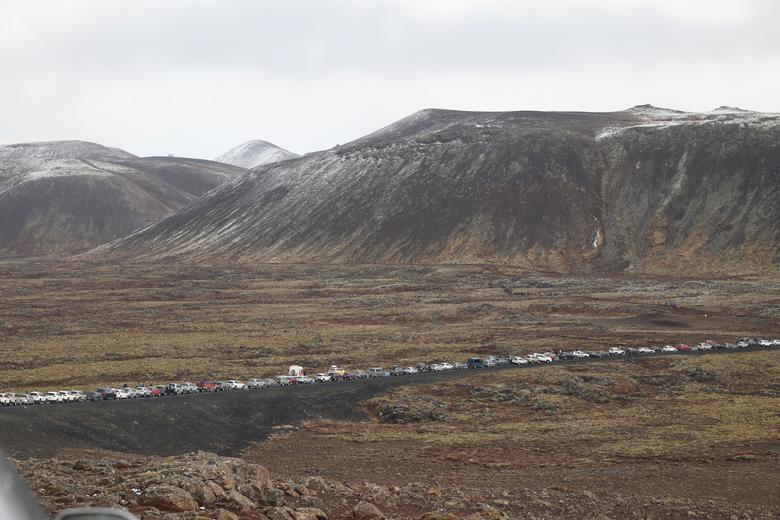 Cars line up on the Reykjanes Peninsula in Iceland March 23. REUTERS/Cat Gundry-Beck
Cars line up on the Reykjanes Peninsula in Iceland March 23. REUTERS/Cat Gundry-Beck
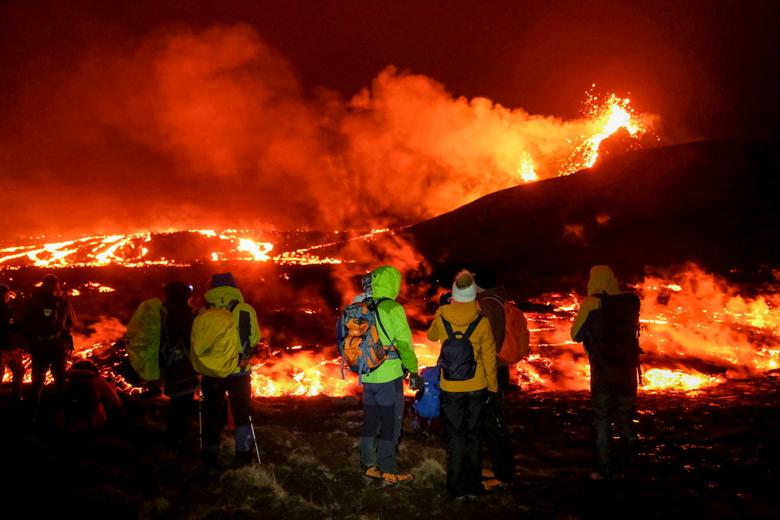 Lava flows from a volcano in Reykjanes Peninsula, Iceland, March 20. Kristinn Magnusson/mbl.is. REUTERS
Lava flows from a volcano in Reykjanes Peninsula, Iceland, March 20. Kristinn Magnusson/mbl.is. REUTERS
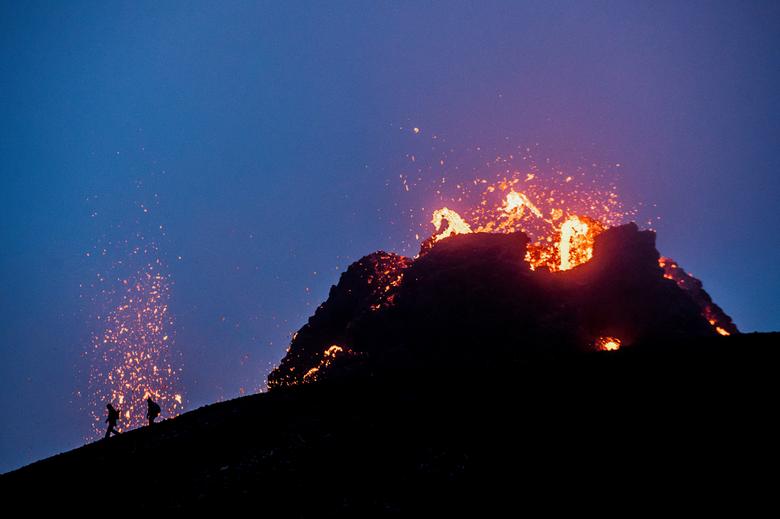 Lava flows from a volcano in Reykjanes Peninsula, Iceland, March 21. REUTERS/Sigtryggur Johannsson
Lava flows from a volcano in Reykjanes Peninsula, Iceland, March 21. REUTERS/Sigtryggur Johannsson
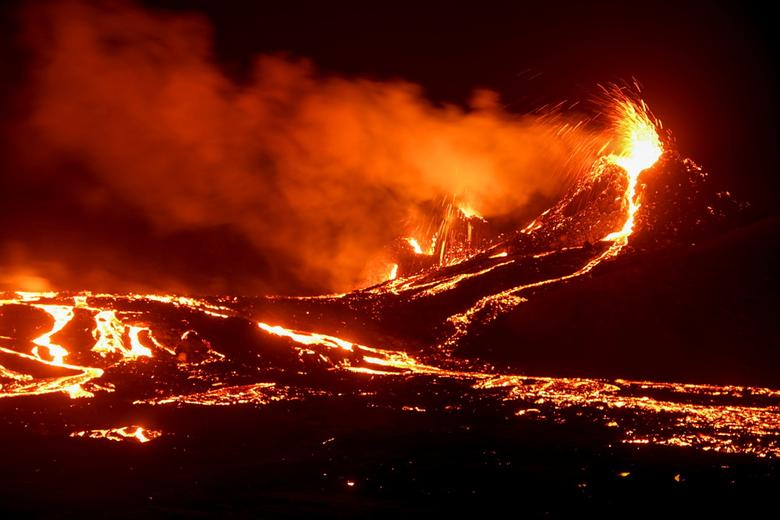 A volcanic eruption in Geldingadalur in Iceland’s Reykjanes peninsula, March 20. Kristinn Magnusson/mbl.is via REUTERS
A volcanic eruption in Geldingadalur in Iceland’s Reykjanes peninsula, March 20. Kristinn Magnusson/mbl.is via REUTERS
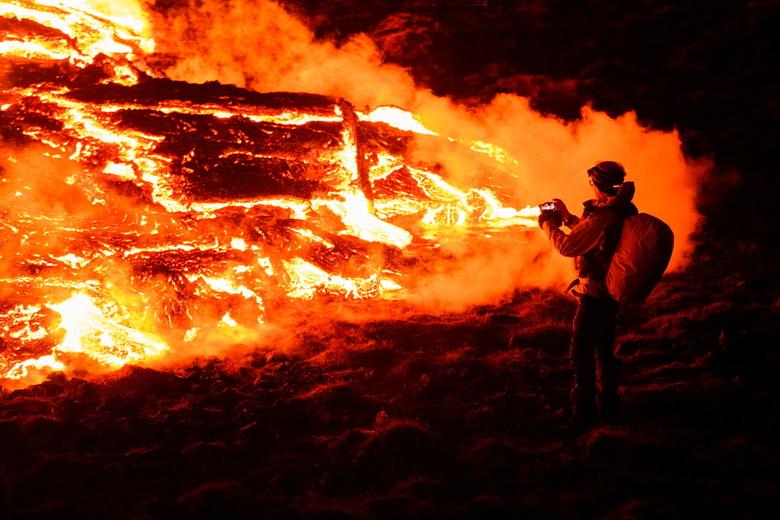 Lava flows from a volcano in Reykjanes Peninsula, Iceland, March 20. Kristinn Magnusson/mbl.is. REUTERS
Lava flows from a volcano in Reykjanes Peninsula, Iceland, March 20. Kristinn Magnusson/mbl.is. REUTERS
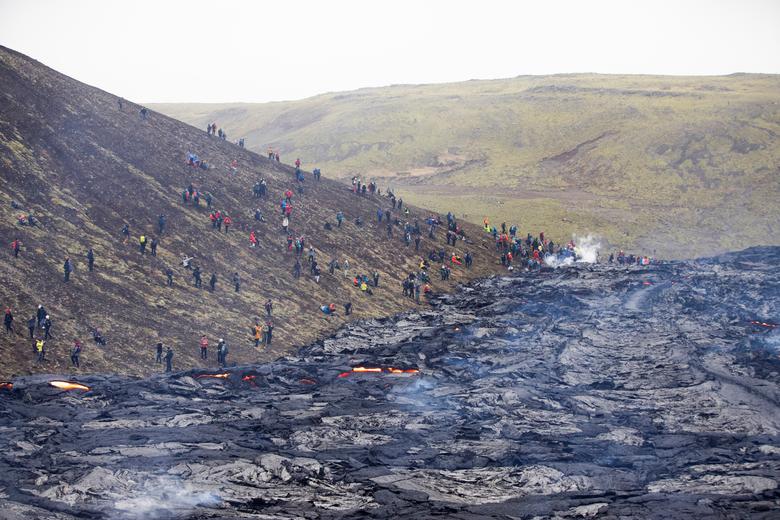 People gather at the volcanic site on Iceland’s Reykjanes Peninsula, March 21. REUTERS/Cat Gundry-Beck
People gather at the volcanic site on Iceland’s Reykjanes Peninsula, March 21. REUTERS/Cat Gundry-Beck
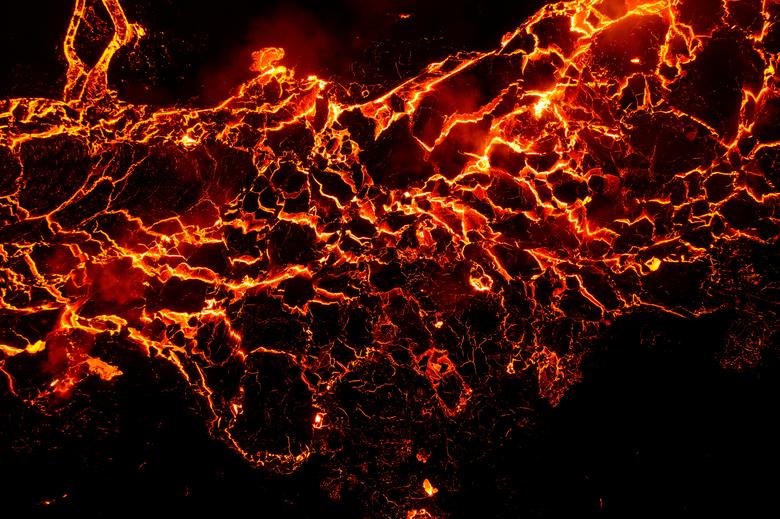 A volcanic site on the Reykjanes Peninsula in Iceland March 27. REUTERS/Cat Gundry-Beck
A volcanic site on the Reykjanes Peninsula in Iceland March 27. REUTERS/Cat Gundry-Beck
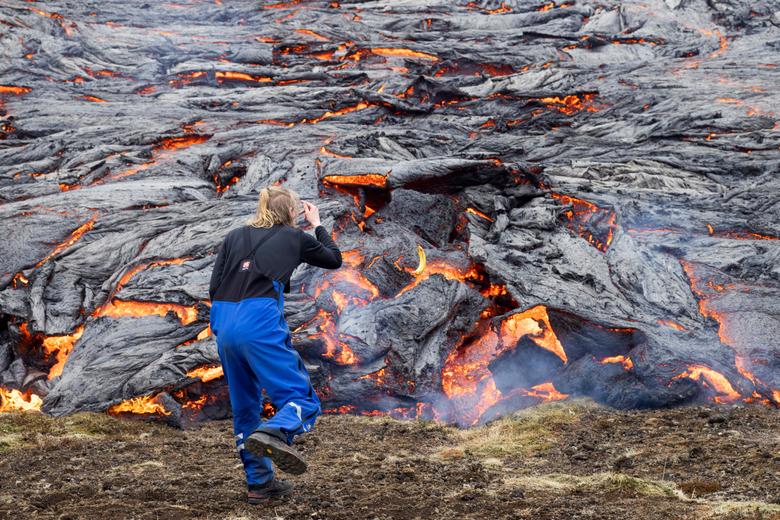 A person looks at the volcanic site on the Reykjanes Peninsula in Iceland, March 21. REUTERS/Cat Gundry-Beck
A person looks at the volcanic site on the Reykjanes Peninsula in Iceland, March 21. REUTERS/Cat Gundry-Beck
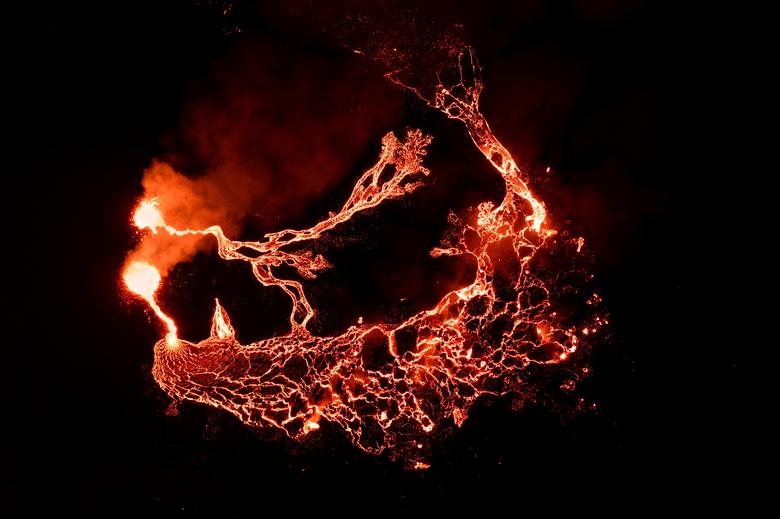 A volcanic site on the Reykjanes Peninsula in Iceland, March 27. REUTERS/Cat Gundry-Beck
A volcanic site on the Reykjanes Peninsula in Iceland, March 27. REUTERS/Cat Gundry-Beck
 A view of a volcanic site on the Reykjanes Peninsula in Iceland, March 26. REUTERS/Cat Gundry-Beck
A view of a volcanic site on the Reykjanes Peninsula in Iceland, March 26. REUTERS/Cat Gundry-Beck
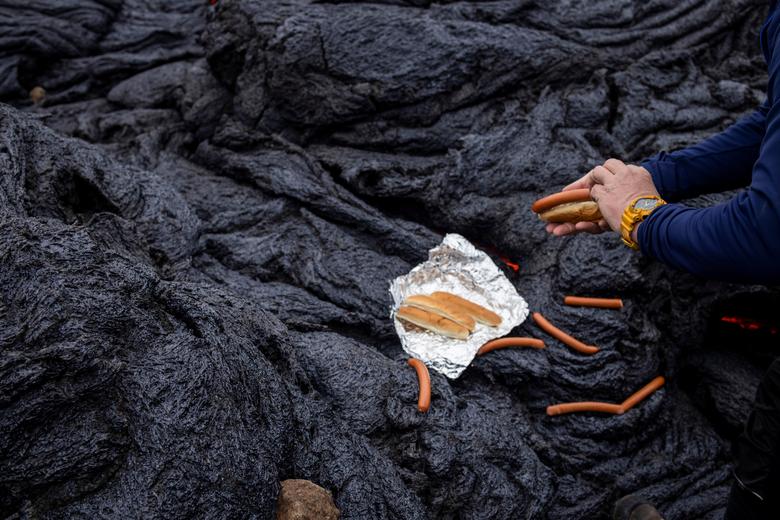 A man prepares hot dogs at the volcanic site on the Reykjanes Peninsula in Iceland, March 21. REUTERS/Cat Gundry-Beck
A man prepares hot dogs at the volcanic site on the Reykjanes Peninsula in Iceland, March 21. REUTERS/Cat Gundry-Beck
 Lava flows from a volcano in Reykjanes Peninsula, Iceland, March 21. REUTERS/Sigtryggur Johannsson
Lava flows from a volcano in Reykjanes Peninsula, Iceland, March 21. REUTERS/Sigtryggur Johannsson
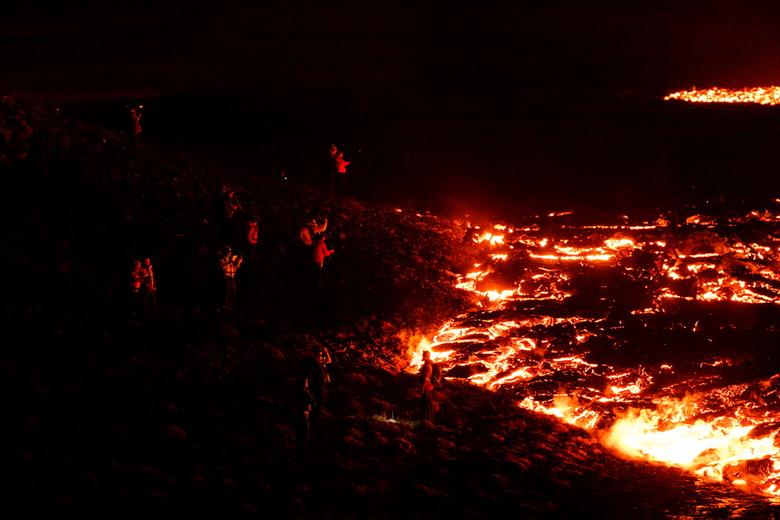 Volcanic eruption in Geldingadalur in Iceland’s Reykjanes peninsula, March 20. Kristinn Magnusson/mbl.is via REUTERS
Volcanic eruption in Geldingadalur in Iceland’s Reykjanes peninsula, March 20. Kristinn Magnusson/mbl.is via REUTERS
 A view of the volcanic site on the Reykjanes Peninsula following Friday’s eruption in Iceland, March 21. REUTERS/Cat Gundry-Beck
A view of the volcanic site on the Reykjanes Peninsula following Friday’s eruption in Iceland, March 21. REUTERS/Cat Gundry-Beck
 Lava oozes at the volcanic site on the Reykjanes Peninsula following Friday’s eruption in Iceland, March 21. REUTERS/Cat Gundry-Beck
Lava oozes at the volcanic site on the Reykjanes Peninsula following Friday’s eruption in Iceland, March 21. REUTERS/Cat Gundry-Beck
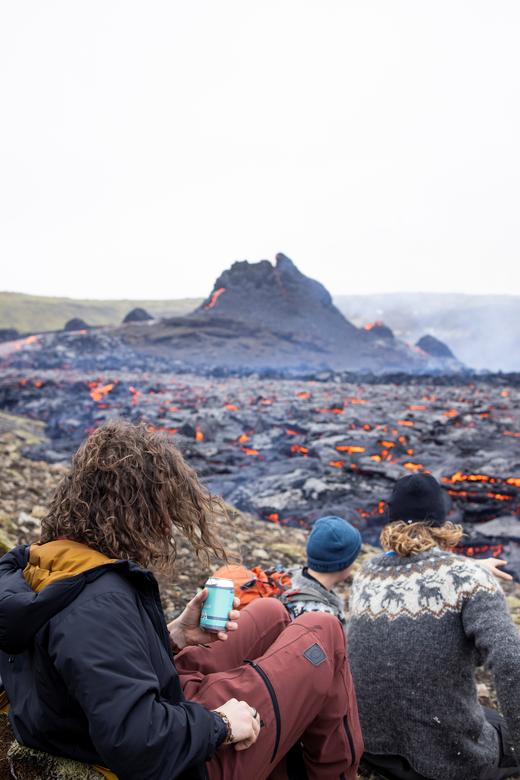 People sit in front of the volcanic site on Iceland’s Reykjanes Peninsula, March 21. REUTERS/Cat Gundry-Beck
People sit in front of the volcanic site on Iceland’s Reykjanes Peninsula, March 21. REUTERS/Cat Gundry-Beck
 A view of the volcanic site on the Reykjanes Peninsula in Iceland March 23. REUTERS/Cat Gundry-Beck
A view of the volcanic site on the Reykjanes Peninsula in Iceland March 23. REUTERS/Cat Gundry-Beck
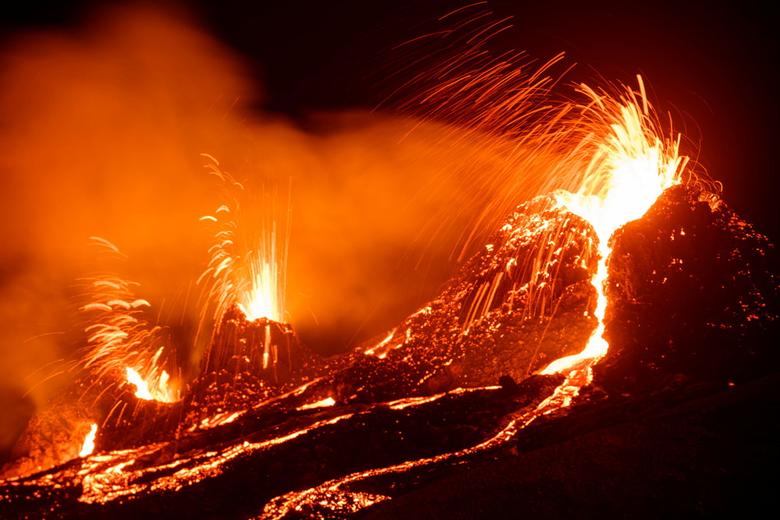 A volcanic eruption in Geldingadalur in Iceland’s Reykjanes peninsula, March 20. Kristinn Magnusson/mbl.is via REUTERS
A volcanic eruption in Geldingadalur in Iceland’s Reykjanes peninsula, March 20. Kristinn Magnusson/mbl.is via REUTERS
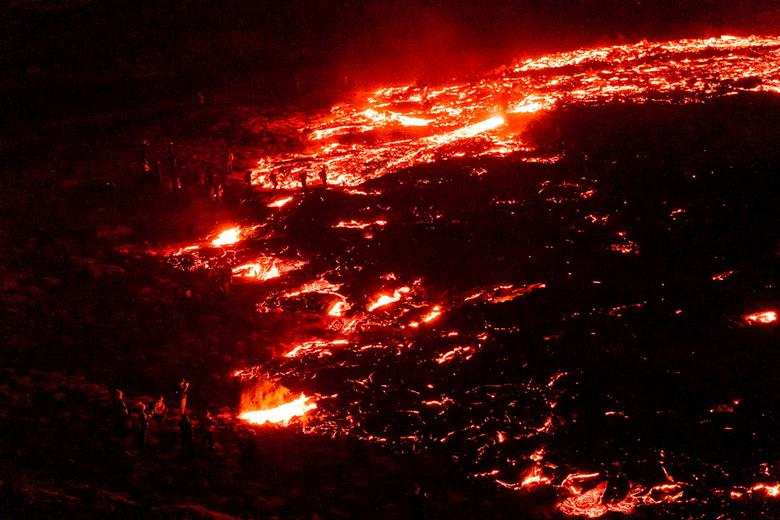 Volcanic eruption in Geldingadalur in Reykjanes peninsula in Iceland, March 20. Kristinn Magnusson/mbl.is via REUTERS
Volcanic eruption in Geldingadalur in Reykjanes peninsula in Iceland, March 20. Kristinn Magnusson/mbl.is via REUTERS
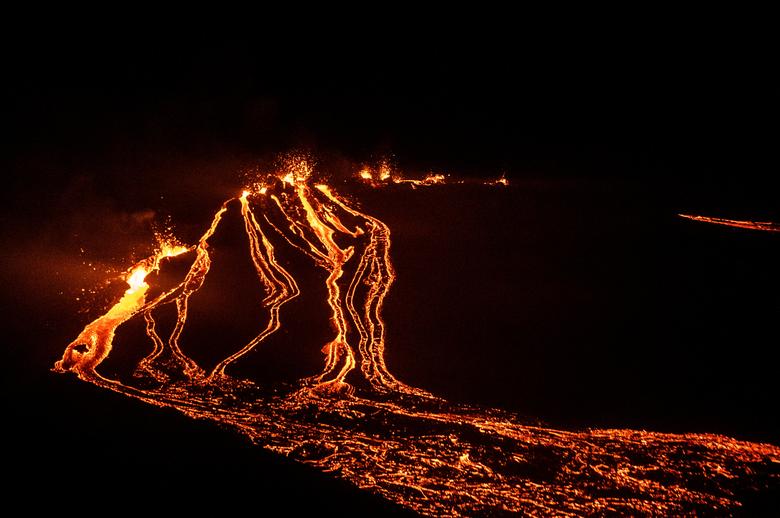 Lava flows from a volcano in Reykjanes Peninsula, Iceland, March 20. REUTERS/Sigtryggur Johannsson
Lava flows from a volcano in Reykjanes Peninsula, Iceland, March 20. REUTERS/Sigtryggur Johannsson
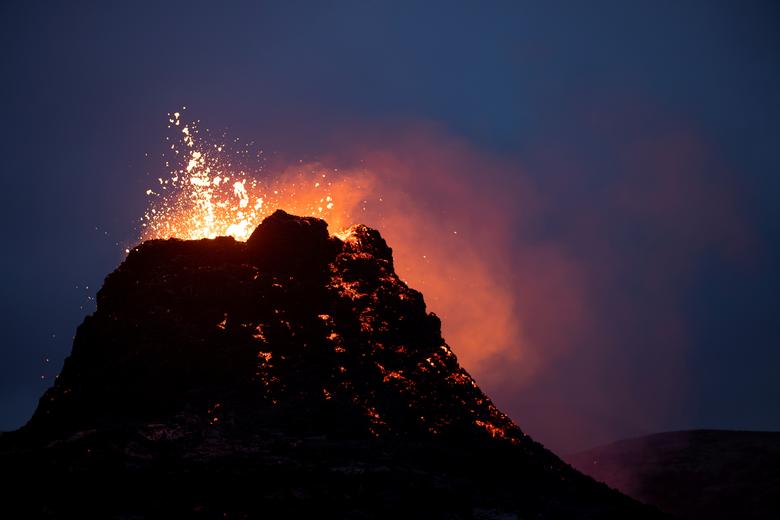 A view of the volcanic site on the Reykjanes Peninsula in Iceland, March 21. REUTERS/Cat Gundry-Beck
A view of the volcanic site on the Reykjanes Peninsula in Iceland, March 21. REUTERS/Cat Gundry-Beck
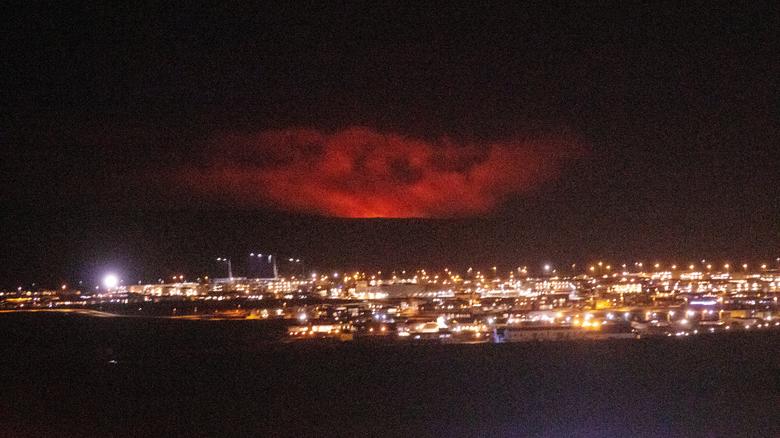 A volcanic eruption is seen (rear) near Fagradalsfjall, a mountain on the Reykjanes Peninsula, Iceland, March 19. VF.IS/via REUTERS
A volcanic eruption is seen (rear) near Fagradalsfjall, a mountain on the Reykjanes Peninsula, Iceland, March 19. VF.IS/via REUTERS
 People gather at the volcanic site on Iceland’s Reykjanes Peninsula, March 21. REUTERS/Cat Gundry-Beck
People gather at the volcanic site on Iceland’s Reykjanes Peninsula, March 21. REUTERS/Cat Gundry-Beck
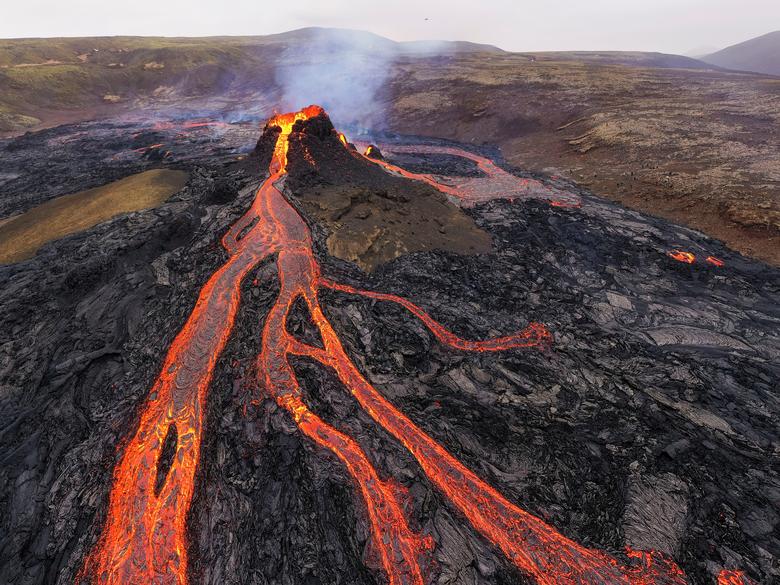 A view of the volcanic site on the Reykjanes Peninsula in Iceland, March 21. REUTERS/Cat Gundry-Beck
A view of the volcanic site on the Reykjanes Peninsula in Iceland, March 21. REUTERS/Cat Gundry-Beck
Iceland volcano eruption offers “most beautiful” lava show
Mar 22, 2021 Global News
Scientists descended on the area near an erupting volcano in Iceland’s southwest on Sunday, as lava continued to pour from the crater near Fagradalsfjall, a mountain on the Reykjanes Peninsula since Friday. Drone footage showed lava spewing from the volcano, as people showed up to film and enjoy the natural phenomenon. Scientists at the foot of the volcano even used its lava as a giant grill to cook up hot dogs as they studied the eruption. The Icelandic Meteorological Office (IMO) which had classified the eruption as small, said measurements showed no volcanic ash had been detected but a high level of volcanic gases had been measured close to the eruption site. “Here is the most beautiful thing that I have seen, this volcano,” a member of Iceland’s Search and Rescue team said. The volunteer group was at the site to make sure spectators were safe. For more info, please go to http://www.globalnews.ca? Subscribe to Global News Channel HERE: http://bit.ly/20fcXDc? Like Global News on Facebook HERE: http://bit.ly/255GMJQ? Follow Global News on Twitter HERE: http://bit.ly/1Toz8mt? Follow Global News on Instagram HERE: https://bit.ly/2QZaZIB? #GlobalNews? #volcano? #iceland?
Iceland volcano: Drone footage captures stunning up-close view of eruption
Mar 24, 2021 Global News
A drone captured stunning close-up shots of lava bubbling in the crater of a volcano on Tuesday that began erupting near Iceland’s capital Reykjavik on Friday. 0:15? The drone operator braved the snow and biked seven kilometres to the volcano which is not accessible by road, and captured lava pouring from the crater, down the side of the volcano, and into a lava field. The eruption, which occurred near Fagradalsfjall, a mountain on the Reykjanes Peninsula in southwest Iceland, followed thousands of small earthquakes in recent weeks and was the first on the peninsula since the 12th century. Drone operator credit: THE EMPIRE PRODUCTIONS/ICEBIKE ADVENTURES Please note: We did not slow down or manipulate the speed of the footage for effect. However, the music was added for your enjoyment. For more info, please go to http://www.globalnews.ca? Subscribe to Global News Channel HERE: http://bit.ly/20fcXDc? Like Global News on Facebook HERE: http://bit.ly/255GMJQ? Follow Global News on Twitter HERE: http://bit.ly/1Toz8mt? Follow Global News on Instagram HERE: https://bit.ly/2QZaZIB? #GlobalNews? #IcelandVolcano?
Volcanic eruption explained – Steven Anderson
Jul 13, 2020 TED-Ed
Dig into the science of how new volcanoes form, and what causes their unpredictable eruptions. — In February of 1942, Mexican farmer Dionisio Pulido thought he heard thunder coming from his cornfield. However, the sound wasn’t coming from the sky. The source was a large, smoking crack emitting gas and ejecting rocks, and would come to be known as the volcano Paricutin. Where do new volcanoes like this come from, and what triggers their unpredictable eruption? Steven Anderson investigates. Lesson by Steven Anderson, directed by Cabong Studios. Animator’s website: https://www.cabongstudios.com.br/? Sign up for our newsletter: http://bit.ly/TEDEdNewsletter? Support us on Patreon: http://bit.ly/TEDEdPatreon? Follow us on Facebook: http://bit.ly/TEDEdFacebook? Find us on Twitter: http://bit.ly/TEDEdTwitter? Peep us on Instagram: http://bit.ly/TEDEdInstagram? View full lesson: https://ed.ted.com/lessons/what-makes…? Thank you so much to our patrons for your support! Without you this video would not be possible! Felipe Hoff, Rebecca Reineke, Cyrus Garay, Victoria Veretilo, Michael Aquilina, William Biersdorf, Patricia Alves Panagides, Valeria Sloan Vasquez, Mike Azarkman, Yvette Mocete, Pavel Maksimov, Victoria Soler-Roig, Betsy Feathers, Samuel Barbas, Therapist Gus, Sai Krishna Koyoda, Elizabeth Parker, William Bravante, Irindany Sandoval, Mark wisdom, Brighteagle, Beatriz Inácio, Mighterbump, Pamela Harrison, Maija Chapman, Liana Switzer, Curtis Light, The Brock, Dianne Palomar, Edgar Campos Barrachina, Maria Lerchbaumer, Ever Granada, Marin Kovachev, Ravi S. R?mphal, Penelope Misquitta, Tekin Gültekin, Jhuval, Hans Peng, Gaurav Mathur, Erik Biemans, Tony, Michelle, Katie and Josh Pedretti, Vaibhav Mirjolkar, Thomas Bahrman, Allan Hayes, Aidan Forero, Uday Kishore, Mikhail Shkirev, Devesh Kumar, Sunny Patel and Anuj Tomar.
The colossal consequences of supervolcanoes – Alex Gendler
Jun 9, 2014 TED-Ed
View full lesson: http://ed.ted.com/lessons/the-colossa…? In 1816, Europe and North America were plagued by heavy rains, odd-colored snow, famines, strange fogs and very cold weather well into June. Though many people believed it to be the apocalypse, this “year without a summer” was actually the result of a supervolcano eruption that happened one year earlier over 1,000 miles away. Alex Gendler describes the history and science of these epic eruptions. Lesson by Alex Gendler, animation by Andrew Foerster.
https://appliedsciences.nasa.gov/our-impact/story/nasa-helps-world-weather-2020-hurricane-season
NASA Helps the World Weather the 2020 Hurricane Season
PROGRAM AREA DISASTERS REGIONNORTH AMERICA SOUTH AMERICA
BREADCRUMB
By Timothy “Seph” Allen, Published Thursday, February 25, 2021
Forecasters predicted an above-normal hurricane season for 2020. They weren’t wrong.
As the 2020 Atlantic hurricane season smashed records with an unprecedented 30 named storms, NASA’s Earth Applied Sciences Disasters Program stood up to the challenge. The Disasters Program helps leaders and responders at national, regional, and local levels leverage NASA’s technology and expertise to assess, predict, and understand disasters’ impacts. The Disasters Program targets a wide range of hazards and disasters, and while NASA is not an operational response agency, the agency offers access to unique resources, relationships, and scientific expertise to those who use it on the ground.
The Atlantic hurricane season, which officially ran from June 1 to Nov. 30, marked the fifth year in a row with above-average hurricane activity. The National Weather Service noted that every mile of the U.S. Atlantic coast was under a tropical watch or warning in 2020. NOAA reported the most billion-dollar disasters in the U.S. in a single year in the 40 years that they have kept track, which hurricanes contributed significantly to. Of twelve named storm systems that made landfall in the continental U.S. in 2020, seven (Hanna, Isaias, Laura, Sally, Delta, Zeta and Eta) each caused over $1 billion in overall damage costs.
This visualization shows the hurricanes and tropical storms of 2020 as seen by NASA’s Integrated Multi-satellitE Retrievals for GPM (IMERG) – a data product combining precipitation observations from infrared and microwave satellite sensors united by the GPM Core Observatory. IMERG rain rates (in mm/hr) are overlaid on infrared cloud data from the NOAA Climate Prediction Center (CPC) Cloud Composite dataset together with storm tracks from the NOAA National Hurricane Center (NHC) Automated Tropical Cyclone Forecasting (ATCF) model. Sea surface temperatures (SST) are also shown over the oceans, derived from the NASA Multi-sensor Ultra-high Resolution (MUR) dataset, which combines data from multiple geostationary and orbiting satellites. Sea surface temperatures play an important role in hurricane formation and development, with warmer temperatures linked to more intense storms. Credits: NASA Goddard Scientific Visualization Studio
Tropical storms and hurricanes were also more active and intense later in the year than usual. “Countries that experience hurricanes are used to that season peaking between July to September,” remarks Ronan Lucey, a researcher at the University of Alabama in Huntsville, working within NASA’s Disasters Program. “This was a long season, and we have to look at the climatic conditions that lead to that.”
2020 Hurricane Season
Feb 25, 2021 NASA Scientific Visualization Studio
This visualization shows the hurricanes and tropical storms of 2020 as seen by NASA’s Integrated Multi-satellitE Retrievals for GPM (IMERG) which measures rain rates (in mm/hr) overlaid on infrared cloud data from the NOAA Climate Prediction Center (CPC) Cloud Composite dataset together with storm tracks from the NOAA National Hurricane Center (NHC) Automated Tropical Cyclone Forecasting (ATCF) model. Sea surface temperatures (SST) are also shown over the oceans, derived from the NASA Multi-sensor Ultra-high Resolution (MUR) dataset, which combines data from multiple geostationary and orbiting satellites. Visualizers: Alex Kekesi (lead), Greg Shirah (lead), Horace Mitchell For more information or to download this public domain video, go to https://svs.gsfc.nasa.gov/4884#30824?
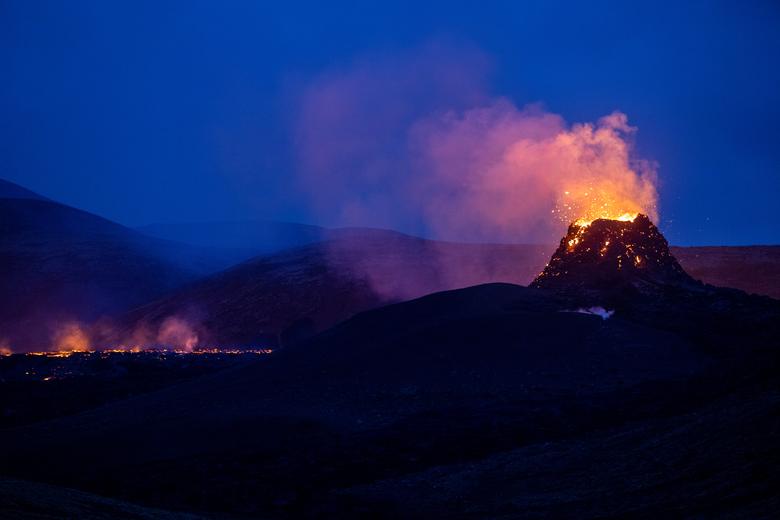
Leave a Reply